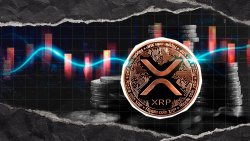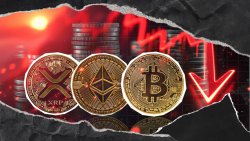- What is “XRPL Fork” Flare?
- What does Flare (FLR) have to do with XRP?
- What is “XRPL Fork” Flare Spark token (FLR) and airdrop?
- Which exchanges support Spark (FLR) airdrop? See full list
- How to get Spark (FLR) tokens for free?
- How to exchange XRP for Spark?
- DeFi on “XRPL Fork” Flare: What has been achieved so far?
- Bottom line
Flare Networks is tasked with the unparalleled experiment of empowering XRP-based remittances tools via smart contract functionality. To achieve this ambitious goal, it launches a new blockchain focused on the XRP user base.
What is “XRPL Fork” Flare?
Flare is a programmatic blockchain based on Avalanche consensus. This means that it can serve as a hosting platform for decentralized applications (dApps), including decentralized financial protocols (DeFis).
Flare will use the world's first Turing complete Federated Byzantine Agreement (FBA) network. This choice allows Flare to support smart contracts designed for Ethereum Virtual Machine (EVM). Thus, Flare will be Ethereum-compatible from day one.
What does Flare (FLR) have to do with XRP?
Given that XRP token is widely used for cross-border transactions by millions of crypto holders every day, as well as by many corporate entities, Flare Networks decided to build its infrastructure involving this community.
However, the new blockchain will be a separate chain built on a consensus different from XRP Ledger’s consensus. Thus, Flare Networks promotes Flare as a “utility fork” of XRP Ledger:
The best community to own the asset that enables the use of XRP with Turing complete smart contracts is the community that will use it and benefit from it: XRP holders. Flare is (...) is doing what we term a utility fork. We believe it’s the first of its kind. A fork traditionally has sought to take the user base of an existing network and depart entirely from that network, usually to have an antagonistic relationship with the original chain. In contrast, a utility fork is intended to bring value back to the original chain instead of moving away from it.
What is “XRPL Fork” Flare Spark token (FLR) and airdrop?
To integrate the most passionate and aggressive community in the crypto sphere, XRP Army, into new blockchain mechanisms, Flare decided to airdrop its token, Spark (FLR). Spark (FLR) will act as a backbone asset of the new system.
Flare Networks will distribute FLR tokens to all interested XRP holders on-boarded by both supporting exchanges and platforms or self-custody instruments like XUMM Wallet or XRPL Toolkit.
FLR will be distributed in a 1:1 proportion to all accounts with non-zero XRP balances. However, some exchanges include in the airdrop only accounts with 25+ XRP.
The balances have been counted as of Dec. 12 - the date on which the XRP wallet snapshot was taken by Flare Networks.
Which exchanges support Spark (FLR) airdrop? See full list
Spark (FLR) tokens will be distributed between XRP holders on the platforms on which they stored their XRP prior to the airdrop or in self-custody wallets.
By the time of the snapshot, more than 60 services confirmed their support for Spark (FLR) distribution, including centralized moguls Binance, Coinbase, Kraken, OKEx, Bitstamp, Revolut and other hardware wallets, including Ledger and D’Cent, and lending/borrowing instruments Celsius, YouHodler and Nexo.
Exchanges that supported Spark (FLR) airdrop: full list
- Binance,
- Binance U.S.,
- Bitstamp,
- eToro,
- Poloniex,
- Coinbase,
- Revolut,
- Bittrex,
- OKEx,
- Kraken,
- Huobi Global,
- Bitfinex,
- Bithumb,
- Bitrue,
- KuCoin,
- Crypto.com,
- Uphold,
- Upbit,
- WazirX,
- Coinspot,
- ZB.com,
- NDAX,
- Bitso,
- Tokens.net,
- BitBNS,
- AltcoinTrader,
- Coinfield,
- BitBay,
- BTC Markets,
- Coinone,
- GoPAX,
- ProBit,
- AnchorUSD,
- Korbit,
- BKex,
- Colodax,
- MiraiEx,
- iTrustCapital,
- CoinEx,
- Gate.io,
- Liquid,
- Bitkub,
- Valr,
- Bitbank,
- Bitay.
All XRP holders who confirmed interest in claiming Spark (FLR) tokens will receive their FLR in accordance with the release schedule. The first round of distribution - 15 percent of Spark (FLR) - will be transferred to XRP holders in early-to-mid 2021 while the remaining 85 percent will be released in 24 to 36 months.
How to get Spark (FLR) tokens for free?
Between the snapshot and the first FLR distribution, there is no way to receive Spark (FLR) tokens. XRP-focused exchange Bitrue is going to list FLR-based IoUs: users can trade FLR-pegged synthetic assets but are unable to withdraw them.
In addition, some exchanges from the list of Spark (FLR) airdrop supporters are now considering the possible listing of FLR. Thus, the token will be liquid and easily accessible, but only after the distribution in Q1-Q2, 2021.

Meanwhile, scammers have already released fraudulent tokens that impersonate FLR on Uniswap (UNI), a leading Ethereum-based DEX, and some low-tier centralized trading platforms.
How to exchange XRP for Spark?
Malefactors have even launched a dedicated website that resembles the official Flare Networks domain closely. Scammers impersonate Flare Network CEO Hugo Philion on Telegram and offer a “premium” closed Spark (FLR) airdrop that is said to be 3x as generous as the legitimate one (for 1 XRP on balance, a token holder receives 3 FLR). To join this “closed” program, crypto enthusiasts should send scammers 0.5-0.9 Ethers.
Needless to say, all of these offerings are blatant scams and can only result in losing all money invested. XRP holders should not be lured by such campaigns.
That said, before the airdrop of FLR, Spark token cannot be exchanged for XRP or any other type of token on exchanges or “over-the-counter” platforms. The Flare Networks team reiterates that FLR token has not even launched on the blockchain.
DeFi on “XRPL Fork” Flare: What has been achieved so far?
Since the release of the first iteration of Flare’s whitepaper on Aug. 10, 2020, its focus on the DeFi segment was emphasized by the Flare team. “Yield farming,” lending/borrowing, DEX, stablecoins: Flare protocol will be able to host all of these instruments.
The first-ever DeFi on “XRPL Fork” Flare, Flare Finance, is already live in devnet, which is based on Flare’s testnet, Coston. According to Flare Finance, the new instrument will allow for the decentralized exchange of Flare-based tokens and support assets farming strategies, including lending/borrowing tools and even rewarding Bitcoin (BTC) and Ethereum (ETH) with bonuses.
Besides Flare Finance, the new blockchain has its first staking entity, ScandiNodes. Immediately after the FLR airdrop, token holders will be able to delegate their tokens - eliminating the need for running nodes directly.
Flare operations can be tracked and analyzed using its native explorer, FlareScan. Just like existing explorer resources (Etherscan, Blockchair, etc.), FlareScan displays the data of blocks, transactions, accounts and other crucial information about blockchain performance.
Bottom line
- “XRPL Fork” Flare is a programmatic Ethereum-compatible blockchain built on Avalanche consensus that hosts dApps and DeFis.
- Flare is focused on bringing smart contracts functionality to XRP transfer instruments, though its Turing-complete mechanism can integrate other blockchains as well.
- To integrate the XRP community, Flare Networks will airdrop Spark (FLR) tokens to all interested XRP holders in a 1:1 proportion. The snapshot of balances for the airdrop was taken on Dec. 12, 2020.
- Spark (FLR) tokens cannot be exchanged or transferred until the airdrop takes place. Its first round will take place in Q1-Q2, 2021.
- The first DeFi, explorer and delegation pool for Flare blockchain - namely Flare Finance, FlareScan, and Scandinodes - have already been released.




